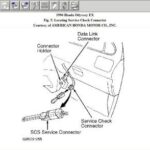What Does OBD2 Code P0446 Mean?
The diagnostic trouble code P0446, known as “Evaporative Emission Control System Vent Control Circuit Malfunction,” is a common issue in modern vehicles equipped with OBD-II systems. This code is considered generic, meaning it can occur in various makes and models manufactured from 1996 onwards. While the definition is consistent across vehicles, the specific diagnostic and repair procedures might differ depending on the manufacturer and model.
At its core, Obd2 P0446 indicates a problem within the Evaporative Emission Control System (EVAP), specifically concerning the vent control circuit. The EVAP system is designed to prevent fuel vapor from escaping into the atmosphere. A crucial component in this system is the evap vent valve. This valve plays a simple but vital role: it closes to seal the EVAP system’s vent, allowing the system to pressurize and detect any leaks.
Typically, the evap vent valve receives 12V battery voltage when the ignition is switched on. The Engine Control Module (ECM) controls the valve by managing the ground circuit. When the ECM grounds the control circuit, it activates the valve, causing it to close. Code P0446 is triggered when the ECM detects an electrical fault in this control circuit – such as a short to ground, an open circuit, or a short to battery voltage. Furthermore, this code can also be set if the ECM determines that the EVAP system is unable to establish or maintain a vacuum during its self-testing procedures.
Symptoms of a P0446 Code
Often, the most noticeable symptom of a p0446 code is the illumination of the Malfunction Indicator Lamp (MIL), commonly known as the “check engine light,” on your dashboard. In many cases, drivers may not experience any other immediately apparent symptoms in terms of vehicle performance. However, it’s important to address this code promptly as it indicates a fault in the emission control system, which can have environmental implications and potentially affect your vehicle’s ability to pass emissions tests.
Potential Causes of OBD2 P0446
Several factors can lead to a P0446 code. Pinpointing the exact cause is crucial for effective repair. Here are some common culprits:
- Faulty Vent Valve: The vent valve itself could be malfunctioning. This might involve internal mechanical failure preventing it from opening or closing correctly, or an electrical fault within the valve solenoid.
- Vent Valve Control Circuit Issues: Problems within the control circuit wiring are frequent causes. This can include:
- Open Circuit: A break in the wiring preventing proper electrical flow.
- Short to Ground: The control circuit wire may be inadvertently grounding, causing the valve to activate unintentionally or preventing proper control.
- Excessive Resistance: Corrosion or damage to wiring or connectors can increase resistance, hindering the signal and valve operation.
- Short to Battery Voltage: The control circuit may be shorting to a power source, causing continuous voltage supply when it shouldn’t be.
- Vent Valve Blockage: Physical obstructions can prevent the vent valve from operating correctly. Debris, dirt, or even spider webs can block the valve or vent lines.
- PCM (Powertrain Control Module) Failure: In rare cases, a fault within the PCM itself, specifically in the driver circuit controlling the vent valve, can trigger a p0446 code. This is usually considered after ruling out other more common causes.
Troubleshooting and Solutions for P0446
Addressing a p0446 code requires a systematic approach to diagnosis and repair. Here are possible solutions, progressing from the most likely and easiest to check:
-
Inspect the Vent Valve and Wiring:
- Visually examine the vent valve for any signs of damage or blockage. Check for loose connections, corroded terminals, or damaged wiring around the valve and along the control circuit.
- Test the vent valve connector for proper voltage supply (typically 12V with the key on).
- Check the ground circuit continuity from the ECM to the vent valve connector.
-
Test Vent Valve Operation:
- Use a scan tool to attempt to command the vent valve to open and close. Listen for a click sound indicating valve activation.
- If possible, manually test the valve by applying voltage and ground to its terminals to see if it actuates.
- Inspect for any blockage in the vent valve or associated vent lines.
-
Circuit Testing:
- Use a multimeter to check for open circuits, shorts to ground, shorts to battery voltage, and excessive resistance in the vent valve control and power circuits as per the vehicle’s wiring diagram.
- Repair any wiring issues found, such as replacing damaged wires or connectors.
-
Vent Valve Replacement:
- If the vent valve is suspected to be faulty after testing, replacing it is a common next step. Ensure you use a compatible replacement part for your vehicle.
-
PCM Diagnosis (Last Resort):
- If all other potential causes have been eliminated, and the wiring and vent valve are confirmed to be in good working order, a PCM fault may be considered. PCM diagnosis and replacement should be performed by a qualified technician, as it may require programming and specialized tools.
It’s important to note that while these steps provide a general guide, consulting a vehicle-specific repair manual or seeking professional diagnostic assistance is recommended for accurate and safe repairs, especially when dealing with electrical and emission control systems.
Other EVAP System Related DTCs: P0440 – P0441 – P0442 – P0443 – P0444 – P0445 – P0447 – P0448 – P0449 – P0452 – P0453 – P0455 – P0456
Do you still have questions about OBD2 code P0446? Join our community forum for free car repair help and expert advice. Post your question in our FREE car repair forums.
Disclaimer: This information is for informational purposes only and should not be considered professional repair advice. We are not liable for any actions taken based on this information. Consult a qualified technician for vehicle repairs.

